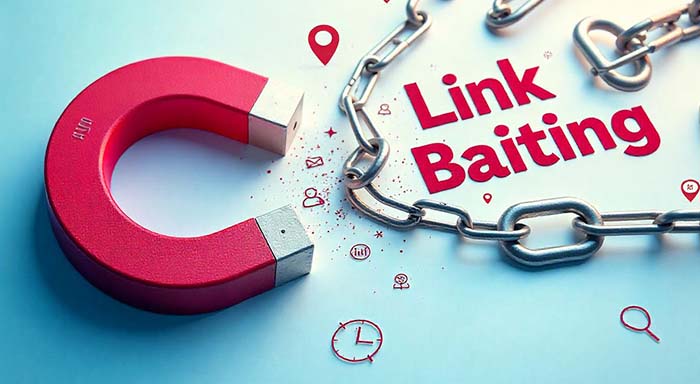Introduction
Backlinks are highly important in the digital marketing world if a website wants to increase its SEO standing and get higher visibility on search engines. Link baiting is one way in which one can achieve this, as it means writing valuable content, that naturally gets other sites to link back to you.
The intricacies of link baiting are known to an extent, the practice is significant, how it can be executed well is at stake, and a few common questions about link baiting are answered in this comprehensive article.
What is Linkbaiting?
In link baiting content marketing, aims to persuade other websites to naturally link to your site. Essentially, it is about creating content that people naturally want to spread around to an audience that is a lot bigger than you possibly could reach on your own.
In other words, it could be anything from in-depth articles, how-to guides, captivating infographics, interesting videos, and more.
Also Read - What Are Forum Backlinks? Are They Still Useful for Link Building?
What is the Importance Of Link baiting?
Link baiting is a strategy that brings the website’s domain authority and search engine ranking. Search engines such as Google view backlinks as endorsements: the more quality links your site gets, the more credible can it look. Higher rankings, more organic traffic, and overall better visibility are the result of this.
Link-Baiting Strategies that Work
1. Create Outstanding Content:
Successful link baiting starts with producing top-tier content that provides for the needs or curiosity of your audience. The content that contains high quality is more likely to receive organic backlinks because it provides true value.
2. Develop Infographics:
As opposed to the usual dry text of documentation, infographics offer information in an easy-to-digest format, visually appealing. These visuals are super shareable and potentially can have a lot of backlinks if they include something unique data or some insight that other people are seeking.
3. Publish Research and Case Studies:
Original research as well as detailed case studies make for good content to attract links. It can prove to be unique as these entities offer new ideas in the industry, as well as data that others in your industry can use to cite in their content.
You can post your informative articles to the host website by guest posting visits to their Write for Us page or similar.
4. Engage with Current Trends:
Producing content on trending topics can significantly boost your link-baiting efforts. Timely content is often sought after by other sites looking to provide up-to-date information on current events or popular trends.
5. Utilize Listicles and Guides:
Articles based on lists and how-to guides work fantastically well when it comes to attracting backlinks because they order information into simple follow steps or points that make for easy sharing.
6. Encourage User Interaction:
You can add interactive content to your pages, such as quizzes, calculators, and polls, and they can really increase active engagement, as well as encourage visitors to share their results which add links back to you.
7. Craft Emotional Content:
Content that evokes emotions can be a great way to generate link bait. Emotional triggers can be humor, surprise, or empathy and get users looking back at your content and sharing.
Measuring your success of link baiting
To gauge the effectiveness of your link-baiting strategies, it is crucial to track several key metrics:
Number of Backlinks:
Tools like Ahrefs or SEMrush can help you track the number of backlinks each piece of content has and how much it’s generating over time.
Referral Traffic:
Check your website’s traffic to determine what portion of it is from external links.
Search Rankings:
Watch your changes in your rank for targeted keywords to see any improvements that could be attributed to successful link bait campaigns.
Engagement Metrics:
Look at how much time a user spent on a page, what percentage bounced off, and how many shares were provided by social.
Best Practices in Link Baiting
Here are some tips to enhance your link-baiting efforts:
Align with Your Brand:
If you want everything to remain authentic, ensure that all the content is in line with your brand’s voice and message.
Prioritize Quality:
Try to get fewer but better quality backlinks as their effect counts more than the links you have.
Avoid Black Hat Tactics:
Be ethical, and don’t use misleading techniques that might violate search engine rules.
Summing Up
Link baiting is a powerful move to execute properly. When you focus on creating great, engaging, and compelling content — you naturally get backlinks that help you improve your site’s SEO and online presence. However, instead of increasing traffic, this approach not only increases traffic but also confirms your status as a thought leader within your industry.
FAQs For Link Baiting
1. How long does it typically take to see results from link baiting?
While results can vary, effective link baiting might start showing benefits in terms of increased backlinks and traffic within a few weeks to several months, depending on the quality of content and industry dynamics.
2. Can link baiting negatively impact my SEO?
As long as ethical practices are adhered to, link baiting should not negatively impact SEO. Engaging in manipulative tactics or publishing low-quality, misleading content could harm your site's SEO and reputation.
3. What types of content are most effective for link baiting?
Content types like infographics, original research reports, in-depth guides, and content addressing current trends are generally effective, as they provide value and are inherently more shareable.
4. Is link baiting applicable across all niches?
Yes, link baiting can be applied across various niches. However, it might require creativity to tailor content that is both unique and relevant to your specific audience.
Related Reads
Paid vs. Free Guest Blogging | Which Is The Right Choice For You?
Guest Blogging: Creating Content Host Can’t Resist
Guest Post Vs Link Insertion | Which SEO Strategy Should You Choose?



